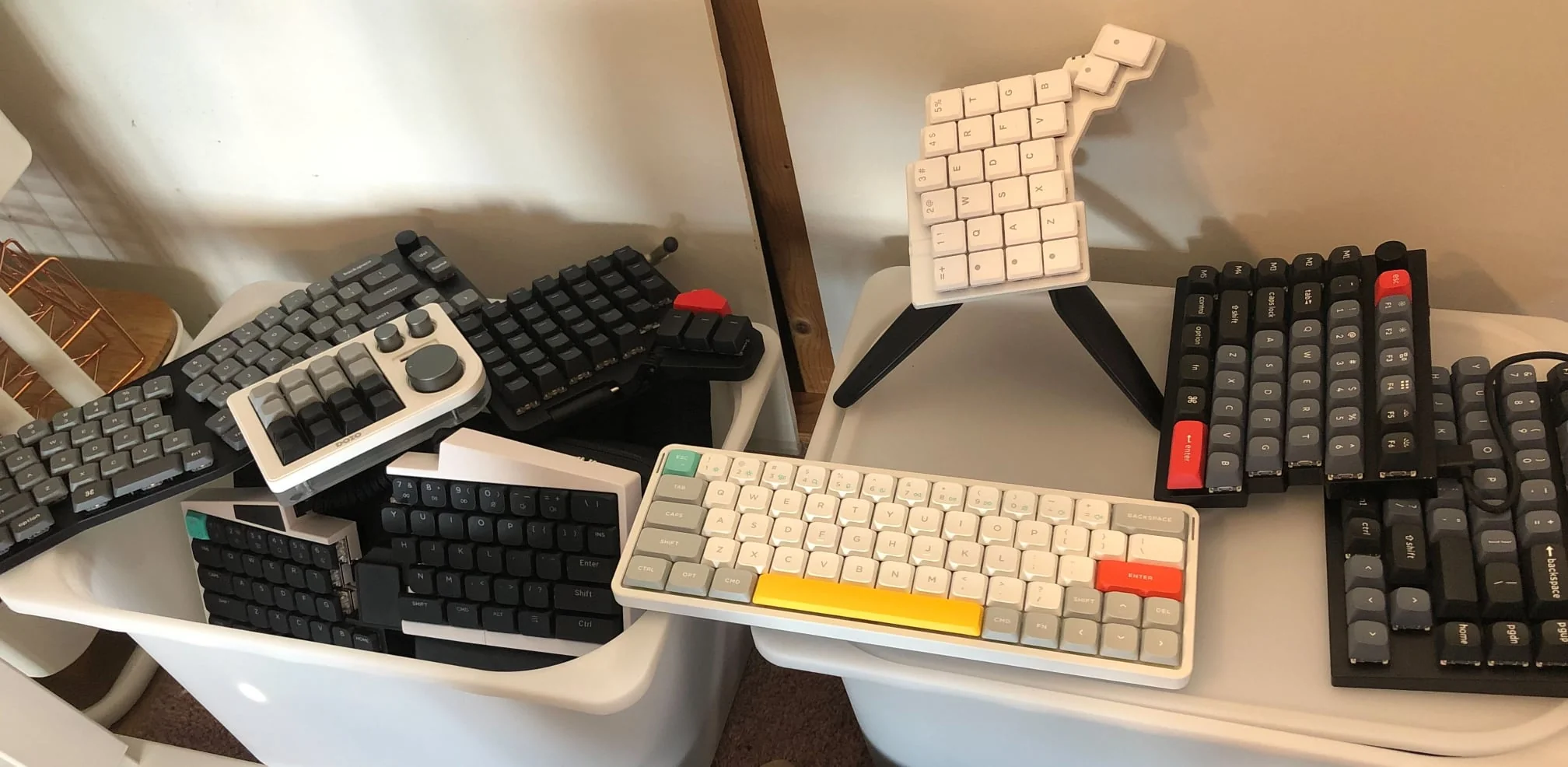Keyboards, keyboards, keyboards
See this photo below?

It all started when I got hit with RSI issues in Febuary of this year. I’ve had RSI before back in college, caused by the excess drawing that the design school had me do, but this was different. I do a fair amount of video editing in my day to day (which can be intensive) which I usually alternate with programming (same issue) and data annotation (ouch). These are all work-related activities that I can't just go ahead and stop, so it was clear that I needed to take it serious.
This led me to investigate ergonomic keyboards as well as some fysio therapy. The therapy did help, so learning how to use the trackpad with my left hand and training myself to type without using my right wrist. This all made a big difference, but only after a small moment of panic in which I bought myself a whole lot of ergonomic keyboards.
!!! quote "Shortlist"
When I say that I bought some keyboards in a state of panic, I am not kidding. Here's my current collection:
- Nuphy Air v2
- UHK v2
- Dygma Raise v1
- Keychron K11 Alice pro
- Keychron Q11
- ZSA Moonlander
- ZSA Voyager, with tenting kit
- Megalodon DOIO
Many of these were bought second hand on Dutch ebay, but it was a fair chunk of change to invest in this.
Some of these keyboards really helped me but I couldn’t help but feel slightly cheated after using some of these boards. The difference between expectation and reality can really be staggering. Part of the issue is that YouTubers, which were my main source of information, are incentivezed to give positive reviews. This puts a lot of content a bit more in “positive” and entertainment”-modes and often lacks depth and education.
They’re certainly not all bad, There are some solid reviewers on Youtube (my favourite two are both called Ben) but there’s a lack of explainers that show what the keyboard is really like to use and how it might (or doesn't) adress specific RSI issues. I want to hear what you should pay attention to when buying an expensive board!
Another part of the issue is that manufacturers do a pretty poor job of explaining when not to buy a keyboard. This is a huge bummer because a lot of the experience really depends on your personal circumstance. I had a pretty nasty fall on my hand during college which means that my right pinky has a lot less strength. Not every keyboard can accomodate that.
It’s a shame, really. When done right, investing in your keyboard really can feel like a 10x investment. But the lack of proper explainers are a missed opportunity. There are some really interesting deep dives you could do into for some of the design decisions of some of these boards. Not to mention how different configurations might spark a new way of working.
And that’s where I think I might be able to contribute something. I’ve been using a wide array of boards for a while now to the extend that I feel able to share some of the advise that I wish that I’d gotten when I first got exposed to this. I’ll try to (somewhat regularly) share something interesting that you can do with your keyboard to make it more friendly for yourself. Some of these techniques involve hardware, others involve software, while others involve habbits and training ... but they all involve rethinking the relationship with your primary input device.
The content will primarily be shared on YouTube, but hopefully I’ll also be able to figure out a nice way to add notes on my blog as well for folks who prefer to read. At the time of writing this blogpost I have two videos that highlight the Nuphy Air v2 keyboard and how you can configure it to be more ergonomic.
Time will tell how much I'll actually be able to allocate to these recordings, but I'm hoping to make a solid start.
!!! quote
ps. If folks have specific questions, feel free to DM me on socials as it might help motivate specific explainers. I’m all ears!
Since writing these blogposts I've made a few more videos. Will be adding them here as they come out.